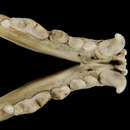Biology
provided by Arkive
The black-footed ferret is an alert, agile, nocturnal animal, which spends the day in prairie dog burrows (7). More than 90 percent of the diet consists of prairie dogs, which are attacked whilst they sleep in their burrows (3), although mice, ground squirrels, voles and other small mammals are also taken (6).
This species is solitary, except during the breeding season, which runs from March to April (6). Females give birth to litters of between three to six young (known as kits), and rear their offspring without help from the male. The young, which are born blind and helpless and covered with thin white hair (3), stay in the burrow for about 42 days before venturing above ground, and remain with their mother until the autumn, after which time they disperse (6). These ferrets have excellent senses of hearing, sight and smell, and olfactory communication (urination and defecation) is very important in the maintenance of dominance hierarchies and following trails at night (6). Vocalisations include chattering and hissing (6).
Conservation
provided by Arkive
The black-footed ferret was thought to be extinct in the 1970s until a last population was discovered in Meeteetse, Wyoming in 1981 (5). Under initial protection measures, this population increased in numbers but then became infected by canine distemper and plague, which threatened to completely wipe out the species (5). As a last resort, the final 18 wild animals were caught and brought into captivity between 1985 and 1987, and a successful captive-breeding programme has been running ever since (3) (8). The US Fish and Wildlife Service's revised 'Black-Footed Ferret Recovery Plan' of 1988 prescribed the long-term target of establishing ten or more separate, self-sustaining wild populations, aiming to have 1,500 ferrets in the wild by 2010 (9). As of 2008, populations had been reintroduced to 18 sites, and with up to 250 wild born individuals distributed amongst several of these populations, the black-footed ferret was reclassified by the IUCN, moving from Extinct in the Wild to Endangered (1). While this is a fantastic conservation success story, wild ferret populations remain small (1), and conservation will need to continue if this species' future is to be secured.
Description
provided by Arkive
Once classified as Extinct in the Wild, the black-footed ferret is one of the world's rarest mammals and the only ferret native to North America (1) (5). This slender animal has a yellowish coloured coat (2), pale underparts (6), and a dark tail tip and black feet (2). The muzzle, throat and forehead are white and there is a black mask around the eyes (6). As with most members of the genus Mustela, the males are larger and much heavier than females (2). The legs are short and the large front paws are armed with claws for digging (3).
Habitat
provided by Arkive
This species is an inhabitant of shortgrass and midgrass prairies (5), where there is an abundance of prairie dog 'towns' (Cynomys species) (7). A very large area of suitable habitat with a large population of prairie dogs is required to support the species; a single black-footed ferret needs between 40 and 60 hectares (7).
Range
provided by Arkive
The black-footed ferret was once common throughout the Great Plains from Alberta in Canada to southwestern USA, but by 1987, the species was extinct in the wild (3). Today, following concerted conservation efforts, reintroduced black-footed ferret populations exist in eight western states and Chihuahua (Mexico) (1) (7) (8). However, only three of these populations, two in South Dakota and one in Wyoming, are considered self-sustaining (1).
Status
provided by Arkive
Classified as Endangered (EN) by the IUCN Red List (1), and listed on Appendix I of CITES (4).
Threats
provided by Arkive
The number of black-footed ferrets plummeted in the first half of the 20th century, primarily as a result of habitat loss. Prairies have been modified for intensive agriculture and there is now less than two percent of the original ferret habitat left (3). The ferret's main prey, prairie dogs, were systematically poisoned in vast tracts of their habitat by a government eradication programme in the mid 1900s (5). Prairie dog burrows were thought to damage cropland and ferret numbers fell in direct proportion with the dramatic decline of their prey (3). The final threat to black-footed ferret numbers, and perhaps the most pertinent today, is disease, particularly canine distemper and plague (3). Plague, introduced to North America, causes even greater devastation in populations of prairie dogs and ferrets than it caused in human populations of Europe and Asia (8).

